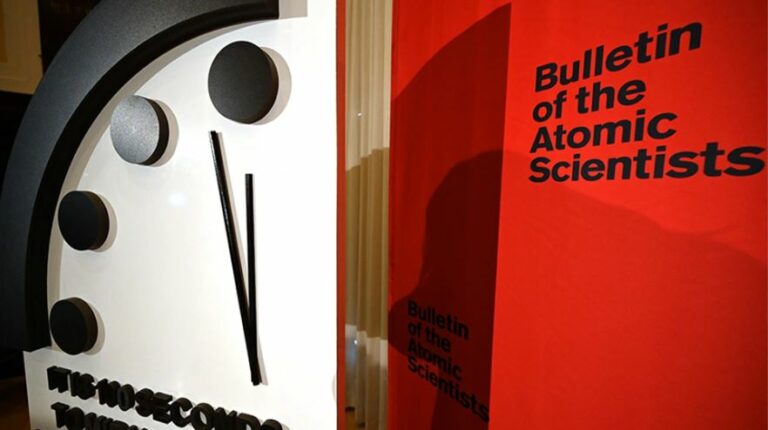Since 1947, the Bulletin of the Atomic Scientists has been tracking world events and assessing how close we are to “destroying our world with dangerous technologies of our own making”. Originally focused on the threat posed by nuclear weapons, the scope has since been broadened to include the effects of climate change (first considered in 2007). The Doomsday Clock metaphor is used to “warn the public” about how close we are thought to be to the worst-case scenario.
In 1947, the clock was started at 7 minutes to midnight – midnight being the point at which it is all too late and the world being destroyed. This assessment was driven mainly by “the prospect that the United States and the Soviet Union were headed for a nuclear arms race”. By 1953, this had been reduced to just two minutes, with the publication proclaiming, somewhat dramatically: “The hands of the clock of doom have moved again. Only a few more swings of the pendulum , and, from Moscow to Chicago, atomic explosions will strike midnight for Western Civilization.”
Seven years later though, the clock had turned back to 7 minutes again and the hands were not to tick as far as in 1953 again until 2018. Then, the Bulletin of the Atomic Scientists wrote” Major nuclear actors are on the cusp of a new arms race, one that will be very expensive and will increase the likelihood of accidents and misperceptions. Across the globe, nuclear weapons are poised to become more rather than less usable because of nations’ investments in their nuclear arsenals.”
Since then, however, the global situation has apparently become even more dire. The latest assessment for 2022 keeps the clock in the same threatening position that it has been in since 2020 – at just 100 seconds to midnight. The main reasoning, without getting to the role of climate change is as follows: ” U.S. relations with Russia and China remain tense, with all three countries engaged in an array of nuclear modernization and expansion efforts. The push to develop hypersonic missiles; and the continued testing of anti-satellite weapons by many nations, If not restrained, could mark the start of a dangerous new nuclear arms race. North Korea’s unconstrained nuclear and missile expansion and the (as yet) unsuccessful attempts to revive the Iran nuclear deal contribute to growing dangers. Ukraine remains a potential flashpoint, and Russian troop deployments to the Ukrainian border heighten day-to-day tensions.”
You will find more infographics at Statista
also read
PM announces 2,000-euros compensation for snowbound motorists on Attiki Odos (photos)
Ask me anything
Explore related questions






